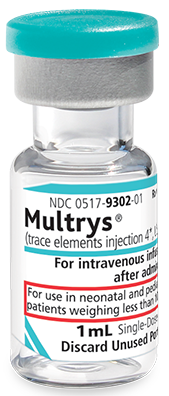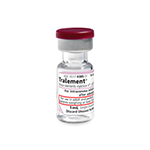This website is intended for use by US healthcare professionals only.
Focus on a Unique Set of Patients
Explore Multrys (trace elements injection 4*, USP)
 Actor Portrayal
Actor PortrayalTrace elements (TEs) are an essential part of parenteral nutrition (PN).1 Per clinical recommendations, patients should receive a daily dose of TEs as part of their PN prescription.2
The concentration of each element in Multrys allows clinicians to treat neonatal and pediatric patients weighing less than 10 kg with accuracy, simplicity, and confidence.3
Multrys is recommended only for pediatric patients who require supplementation with all four of the individual trace elements (ie, zinc, copper, manganese, and selenium).

Actor Portrayal
- The first and only FDA-approved multi-trace element (MTE) injection for patients weighing less than 10 kg4
- Specifically designed as a source of zinc, copper, manganese, and selenium for parenteral nutrition when oral or enteral nutrition is not possible, insufficient, or contraindicated3
Formulated to meet today’s guidelines
- Multrys more closely aligns with the American Society for Parenteral and Enteral Nutrition (ASPEN) Dosing Recommendations for trace element supplementation than products previously marketed by American Regent2,3
- Multrys is not recommended for patients who may require a lower dosage of 1 or more of the individual trace elements. Multrys may not provide the recommended daily dosage of zinc, copper, or selenium in certain weight bands.1

Actor Portrayal
Making Parenteral Nutrition (PN) More Elemental
Multrys may help simplify treatment planning and preparation. This frees you to focus on your patients with greater accuracy, simplicity, and confidence—the way it should be.
Elements of Accuracy
- The recommended dose of Multrys is 1 mL for patients 3 kg-9.9 kg3
Elements of Simplicity
- Fewer compounding steps than using individual trace elements
- Additional trace element supplementation may be necessary in certain weight bands
- Multrys can be stored for up to 9 days when added to the PN admixture and refrigerated [2°C to 8°C (36°F to 46°F)], allowing for the preparation of PN admixtures in advance3
Elements of Confidence
- With American Regent, you can feel confident in our commitment to providing a consistent supply of trace elements to ensure that patient needs are met

You are encouraged to report Adverse Drug Events (ADEs) to American Regent:
Email: pv@americanregent.com
Phone: 1.800.734.9236
Fax: 1.610.650.0170
ADEs may also be reported to the FDA:
1.800.FDA.1088 or to fda.gov/safety/medwatch.
Medical Information:
1.888.354.4855
(9:00 AM–5:00 PM Eastern Time, Monday–Friday)
For medical inquiries outside of business hours that cannot wait until the next business day, please call 1.877.845.6371.
You can also request medical information by visiting our website at https://americanregent.com/medical-affairs/.
Tralement and Multrys are produced by American Regent
With more than 50 years of generic and specialty hospital injectable experience, we are committed to bringing safe, affordable parenteral micronutrient products to the clinical community.
- American Regent is among the leading injectable manufacturers in the US
- We are committed to ongoing education support regarding trace elements and parenteral nutrition
- Tralement and Multrys are proudly manufactured in America






References:
- Blaauw R, Osland E, Sriram K, et al. Parenteral provision of micronutrients to adult patients: an expert consensus paper. JPEN J Parenter Enteral Nutr. 2019;43(suppl 1):S5-S23.
- American Society for Parenteral and Enteral Nutrition. Appropriate dosing for parenteral nutrition: ASPEN Recommendations. Published November 17, 2020. Accessed August 12, 2024. http://www.nutritioncare.org/uploadedFiles/Documents/Guidelines_and_Clinical_Resources/PN%20Dosing%201-Sheet-FINAL.pdf.
- Multrys (trace elements injection 4*, USP). Package insert. Shirley, NY: American Regent, Inc.
- Orange book: approved drug products with therapeutic equivalence evaluations: product details for NDA 209376. US Food & Drug Administration. Multrys and Tralement: Accessed August 12, 2024. https://www.accessdata.fda.gov/scripts/cder/ob/results_product.cfm?Appl_Type=N&Appl_No=209376.
INDICATIONS AND IMPORTANT SAFETY INFORMATION
Tralement (trace elements injection 4*, USP)
*Each mL of Tralement contains zinc 3 mg, copper 0.3 mg, manganese 55 mcg, and selenium 60 mcg.
For intravenous use
IMPORTANT SAFETY INFORMATION
CONTRAINDICATIONS
Tralement is contraindicated in patients with hypersensitivity to zinc or copper.
WARNINGS AND PRECAUTIONS
- Pulmonary Embolism due to Pulmonary Vascular Precipitates: Pulmonary vascular precipitates causing pulmonary vascular emboli and pulmonary distress have been reported in patients receiving parenteral nutrition. If signs of pulmonary distress occur, stop the infusion and initiate a medical evaluation.
- Vein Damage and Thrombosis: Tralement must be prepared and used as an admixture in parenteral nutrition solution. It is not for direct intravenous infusion. In addition, consider the osmolarity of the final parenteral nutrition solution in determining peripheral versus central administration. Solutions with osmolarity of 900 mOsmol/L or more must be infused through a central catheter. The primary complication of peripheral access is venous thrombophlebitis.
- Neurologic Toxicity with Manganese: Monitor patients receiving long-term parenteral nutrition solutions containing Tralement for neurologic signs and symptoms, and routinely monitor whole blood manganese concentrations and liver function tests. Discontinue Tralement and consider brain magnetic resonance imaging (MRI) if toxicity suspected.
- Hepatic Accumulation of Copper and Manganese: If a patient develops signs or symptoms of hepatic or biliary dysfunction during the use of Tralement, obtain serum concentrations of copper and ceruloplasmin as well as manganese whole blood concentrations. Consider using individual trace element products in patients with hepatic and/or biliary dysfunction.
- Aluminum Toxicity: Tralement contains aluminum that may be toxic. Increased risk in patients with renal impairment. Preterm infants, including preterm neonates, are particularly at risk.
- Monitoring and Laboratory Tests: Monitor blood zinc, copper, manganese, and selenium concentrations, fluid and electrolyte status, serum osmolarity, blood glucose, liver and kidney function, blood count, and coagulation parameters.
- Hypersensitivity Reactions with Zinc and Copper: If hypersensitivity reactions occur, discontinue Tralement and initiate appropriate medical treatment.
ADVERSE REACTIONS
The following adverse reactions were identified in clinical studies or post-marketing reports. Given that some of these reactions were reported voluntarily from a population of uncertain size, it is not always possible to reliably estimate their frequency or establish a causal relationship to drug exposure.
Adverse reactions with other components of parenteral nutrition solutions:
- Pulmonary embolism due to pulmonary vascular precipitates
- Vein damage and thrombosis
- Aluminum toxicity
Adverse reactions with the use of trace elements administered parenterally or by other routes of administration:
- Neurologic toxicity with manganese
- Hepatic accumulation of copper and manganese
- Hypersensitivity reactions with zinc and copper
USE IN SPECIFIC POPULATIONS
Pregnancy - Risk Summary - Deficiency of trace elements may result in adverse pregnancy and fetal outcomes.
Lactation - Risk Summary - Zinc, copper, manganese, and selenium are present in human milk. The developmental and health benefits of breastfeeding should be considered, along with the mother’s clinical need for Tralement and any potential adverse effects on the breastfed infant from Tralement or from the underlying maternal condition.
Pediatric Use - Refer to Full Prescribing Information for dosing. Do not supplement Tralement with additional manganese. Tralement is not approved for use in pediatric patients weighing less than 10 kg because the product does not provide an adequate dosage of zinc, copper, or selenium to meet the needs of this subpopulation and exceeds the recommended dosage of manganese.
Hepatic Impairment - Hepatic accumulation of copper and manganese have been reported with long-term administration in parenteral nutrition. For patients with cholestasis, biliary dysfunction, or cirrhosis, monitor hepatic and biliary function during long-term administration of Tralement.
OVERDOSAGE - There are reports on overdosage in the literature for the individual trace elements. Management of overdosage is supportive care based on presenting signs and symptoms.
Tralement is recommended only for patients who require supplementation with all four of the individual trace elements (ie, zinc, copper, manganese, and selenium).
INDICATIONS AND USAGE
Tralement is indicated in adult and pediatric patients weighing at least 10 kg as a source of zinc, copper, manganese, and selenium for parenteral nutrition when oral or enteral nutrition is not possible, insufficient, or contraindicated.
For additional safety information, please see Full Prescribing Information.
You are encouraged to report Adverse Drug Events (ADEs) to American Regent, Inc. at 1-800-734-9236, or to the FDA by visiting fda.gov/safety/medwatch or calling 1-800-FDA-1088.
REF-1535 7/2024
Multrys (trace elements injection 4*, USP)
*Each mL of Multrys provides zinc 1,000 mcg, copper 60 mcg, manganese 3 mcg, and selenium 6 mcg.
For intravenous use
IMPORTANT SAFETY INFORMATION
CONTRAINDICATIONS
Contraindicated in patients with hypersensitivity to zinc or copper.
WARNINGS AND PRECAUTIONS
Pulmonary Embolism due to Pulmonary Vascular Precipitates: Pulmonary vascular precipitates causing pulmonary vascular emboli and pulmonary distress have been reported in patients receiving parenteral nutrition. If signs of pulmonary distress occur, stop the parenteral nutrition infusion and initiate a medical evaluation.
Vein Damage and Thrombosis: Multrys must be prepared and used as an admixture in parenteral nutrition solution. It is not for direct intravenous infusion. In addition, consider the osmolarity of the final parenteral nutrition solution in determining peripheral versus central administration. Solution with an osmolarity of 900 mOsmol/L or greater must be infused through a central catheter. The infusion of hypertonic nutrient solution into a peripheral vein may result in vein irritation, vein damage, and/or thrombosis.
Neurologic Toxicity with Manganese: Monitor for clinical signs and symptoms of neurotoxicity, whole blood manganese concentrations, and liver function tests. Discontinue Multrys and consider brain magnetic resonance imaging (MRI) if toxicity is suspected. Monitor patients for cholestasis or other biliary liver disease.
Hepatic Accumulation of Copper and Manganese: If a patient develops signs or symptoms of hepatobiliary disease during the use of Multrys, obtain serum concentrations of copper and ceruloplasmin as well as manganese whole blood concentrations; consider using individual trace element products in these patients.
Aluminum Toxicity: Multrys contains aluminum that may be toxic. Patients with renal impairment and preterm infants, including preterm neonates, are particularly at risk.
Monitoring and Laboratory Tests: Monitor blood zinc, copper, and selenium serum concentrations, whole blood manganese concentration, fluid and electrolyte status, serum osmolarity, blood glucose, liver and kidney function, blood count, and coagulation parameters.
Hypersensitivity Reactions with Zinc and Copper: If hypersensitivity reactions occur, discontinue and initiate appropriate medical treatment.
ADVERSE REACTIONS
The following adverse reactions were identified in clinical studies or post-marketing reports. Given that some of these reactions were reported voluntarily from a population of uncertain size, it is not always possible to reliably estimate their frequency or establish a causal relationship to drug exposure.
Adverse reactions with other components of parenteral nutrition solutions:
- Pulmonary embolism due to pulmonary vascular precipitates
- Vein damage and thrombosis
- Aluminum toxicity
Adverse reactions with the use of trace elements administered parenterally or by other routes of administration:
- Neurologic toxicity with manganese
- Hepatic accumulation of copper and manganese
- Hypersensitivity reactions with zinc and copper
USE IN SPECIFIC POPULATIONS
Hepatic Impairment - Hepatic accumulation of copper and manganese have been reported with long-term administration in parenteral nutrition. For patients with cholestasis, biliary dysfunction, or cirrhosis, monitor hepatic and biliary function during long-term administration of Multrys.
OVERDOSAGE
There are reports on overdosage in the literature for the individual trace elements. Management of overdosage is supportive care based on presenting signs and symptoms.
INDICATIONS AND USAGE
Multrys is a combination of trace elements (zinc sulfate, cupric sulfate, manganese sulfate, and selenious acid) indicated in neonatal and pediatric patients weighing less than 10 kg as a source of zinc, copper, manganese, and selenium for parenteral nutrition when oral or enteral nutrition is not possible, insufficient, or contraindicated.
For additional safety information, please see Full Prescribing Information.
You are encouraged to report Adverse Drug Events to American Regent, Inc. at 1-800-734-9236, or to the FDA by visiting fda.gov/safety/medwatch or by calling 1-800-FDA-1088.
REF-1826 7/2024

